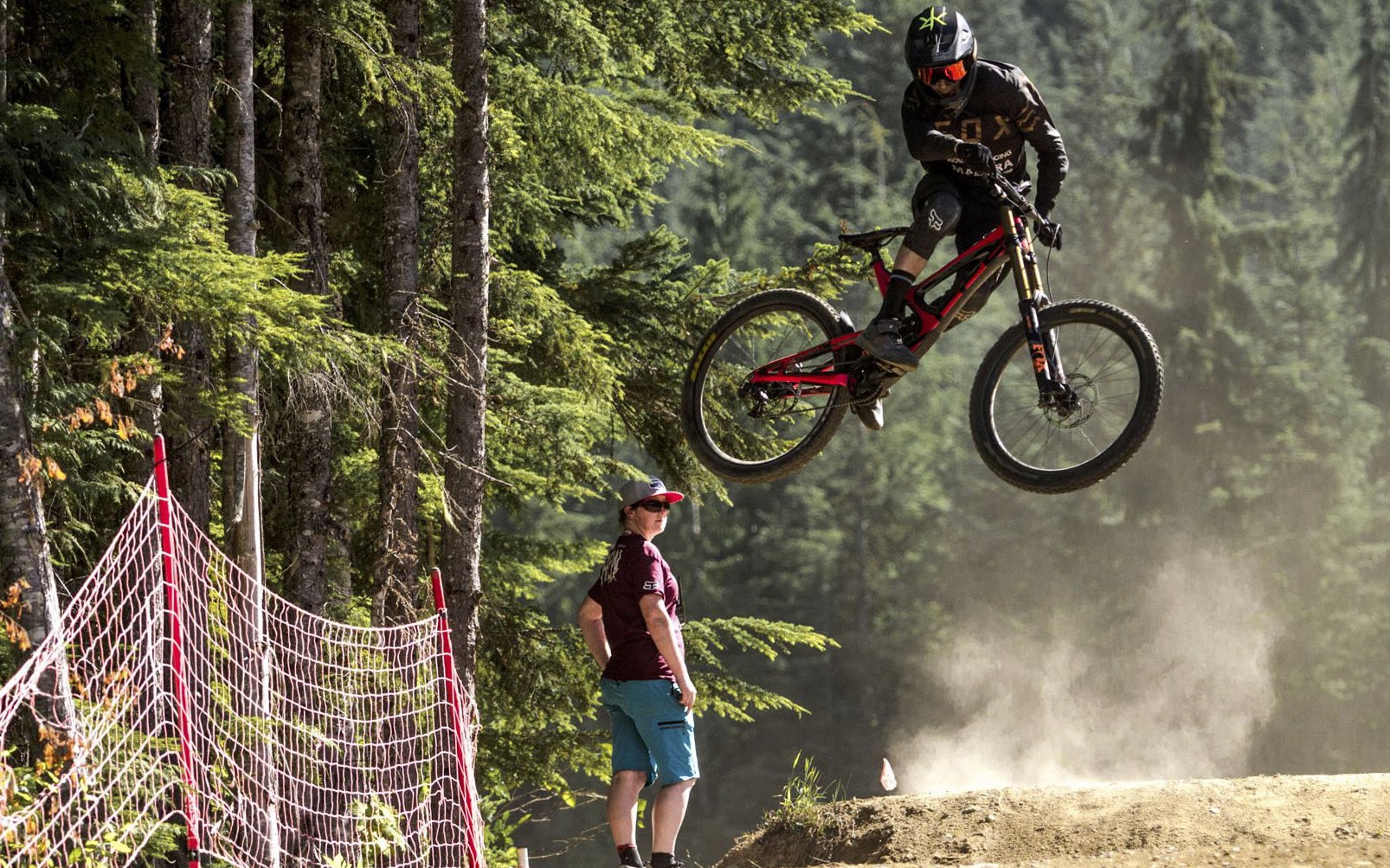
EDITORIAL
Is Your Riding Posture from 2006?
Sometimes I have an article written in my head only to be assaulted by discordant info, which ruins the narrative. As I was today. Ruin is too strong, but today’s ride drained a steaming yellow stream in the eye of my epic revelations.
The thing is, these were no run of the mill revelations; I had solved mountain biking. I made a small change to my set up, which may or may not have helped, and made a more dramatic shift in my riding posture, which seemed to have shifted the universe. Consecutive days when rides that were difficult felt easy, and going fast (for me) seemed effortless had fooled me into thinking I had it all figured out.
*Cover image- Ben Wallace competing at Whip Off Worlds at Crankworx
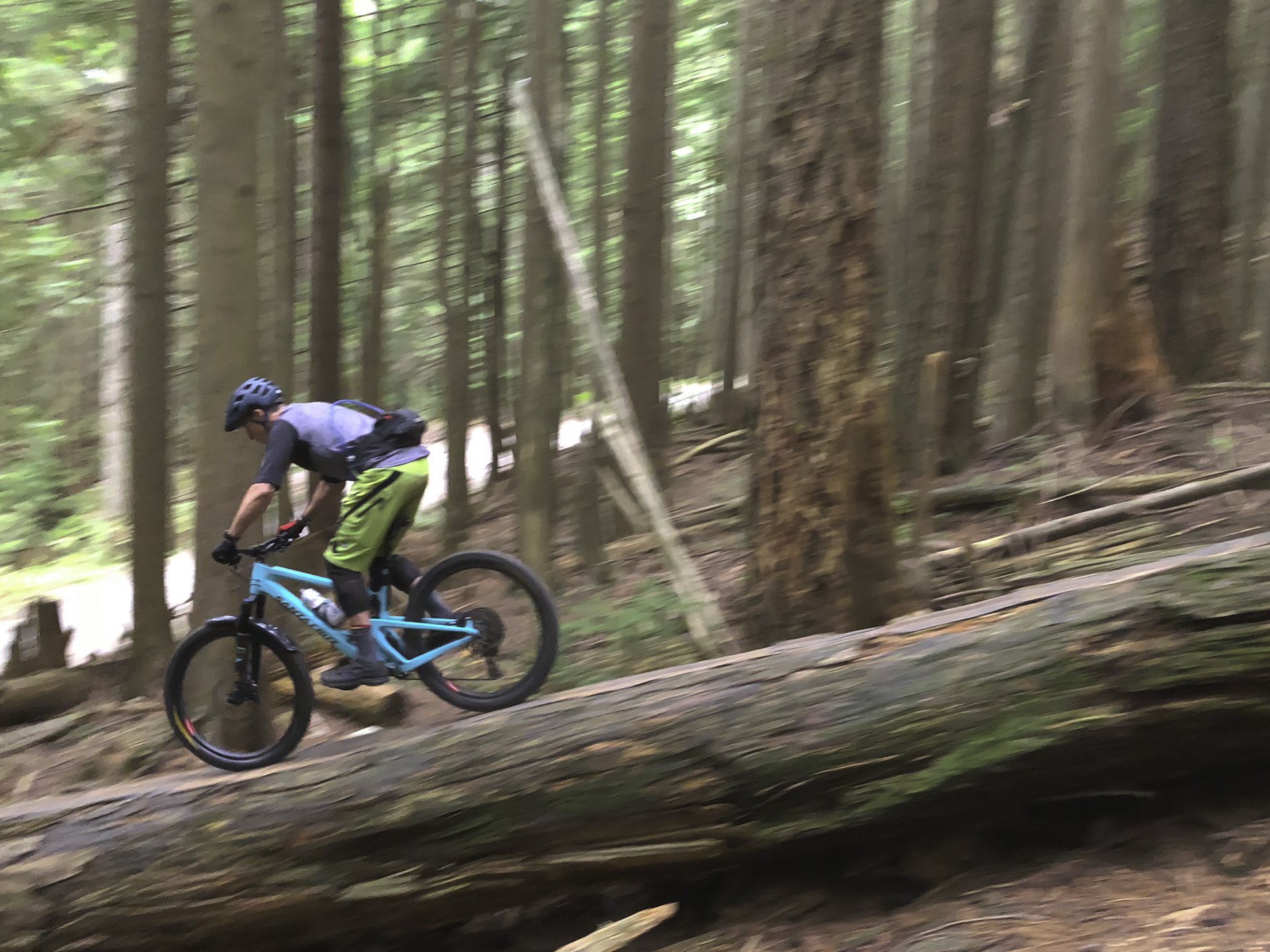
This doesn't look like a bad shape to me, but I bet it would get ripped apart by the experts. Photo - Pedro Chambré
Last week I angled my levers up significantly from their steeply pitched perches. I didn’t go to flat like fast Frenchies Remi Metaillier and Yoann Barelli, but I split the difference between horizontal and their original angle. Now they are at about 20 degrees down. Nothing got worse, and I was riding well, but I didn’t notice anything groundbreaking. I’ve got no desire to put them back though and that’s partially related to another change I made at the suggestion of a friend, who in turn had the same suggestion from his son.
But I’m getting ahead of myself. Let’s back up a little. Or a lot. To 2006 or so, when some friends and I did a private morning session with Shaums March. It was my first time getting any kind of instruction riding a mountain bike since I’d started riding in 1984,* and the last in fact.
*At the age of 6
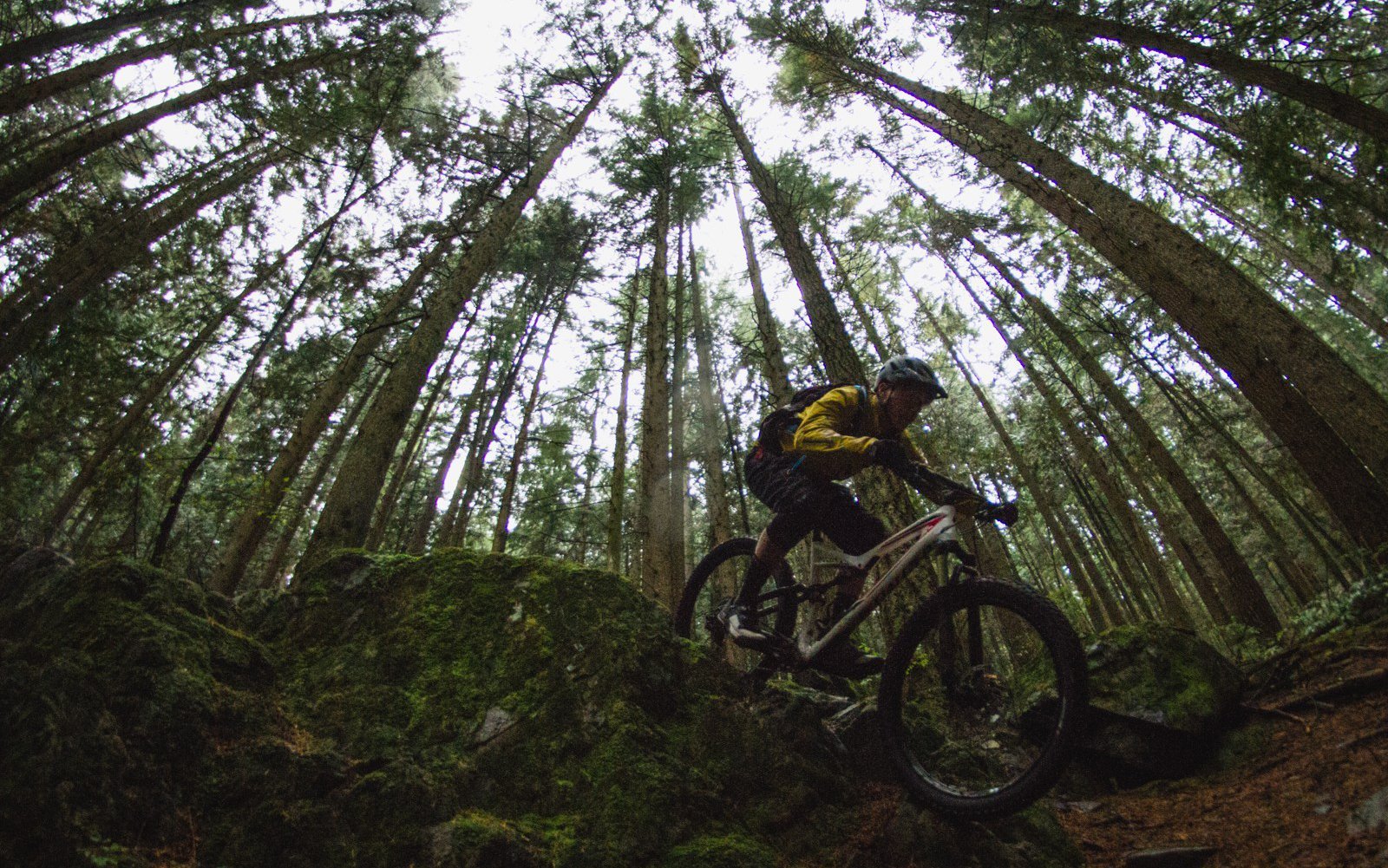
This looks wrong on every level. Photo - Kaz Yamamura
I felt like I had a pretty good idea about what Shaums told us, considering that half day has influenced my riding every day since, but many of the details are lost. Fortunately my buddy Mike Wallace took notes, and he just happened to find them this week. Mike wrote down things like elbows out, shoulders wide, nose over stem and butt out. Much of the stuff he taught us was more subtle than that and tailored to each of us, but these were clearly emphasized.
As I’ve mentioned before, Mike’s son has raced three seasons on the World Cup DH circuit, two as a junior and last year in the senior ranks. Occasionally Ben Wallace comes out to ride with us old hacks. It’s spectacular watching him take lines we never knew existed and making everything look easy. He somehow manages to not make us feel like putzes as well.
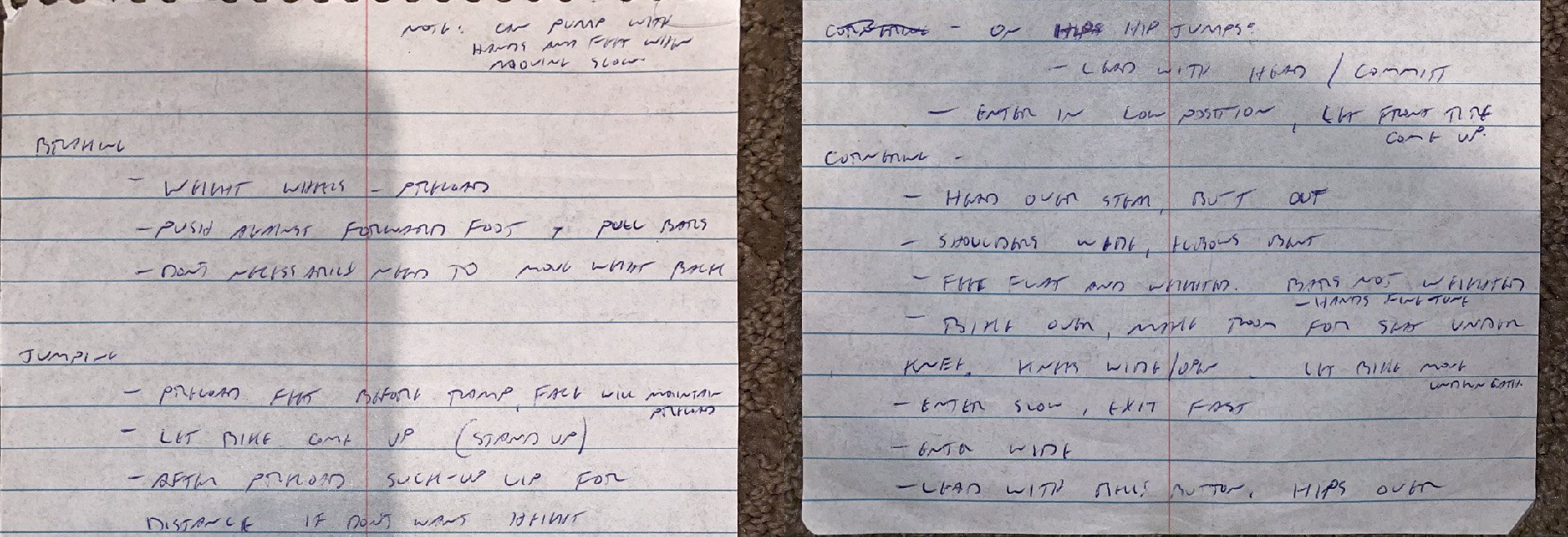
Mike Wallace's 14-year old notes from our coaching session with Shaums March. He's not even a doctor.
Ben never shares any hints or tips on these rides but he’ll drop a few learning points to his dad after the ride. The first point I heard was that we are all too stiff on the bike. Rather than flowing like water down the trail, we flow like furniture. I’ve been paying attention since that point and consciously trying to be more smooth and loose at the contact points and with the rest of my bones as well and I think it’s made a difference in terms of control, traction and general awareness of what’s happening on the trail.
A few months later Mike dropped another gem from Ben’s youthful book of wisdom. Ben told Mike the riding position we old bastards all seemed to cling to, our elbows out, ass back, chest down posture, wasn’t doing us any favours. When I first heard this I was skeptical. I thought low was fast. Low gives you control and the ability to react to whatever is happening. Don’t World Cup racers get low?
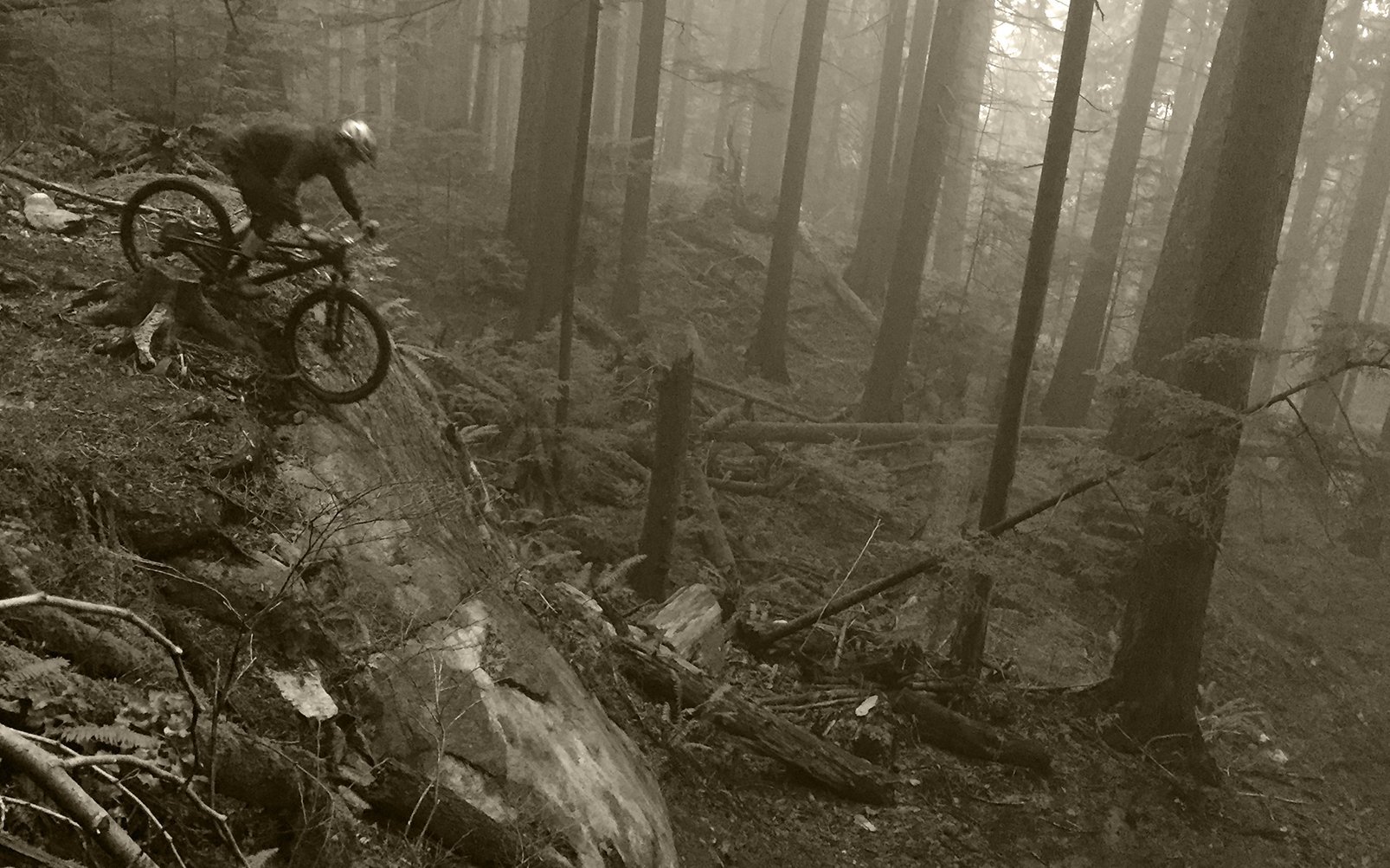
Ben Wallace riding with us old dads in 2018 or so. Photo - Cam McRae
As related by Mike, Ben said that while there are times to get low and aggressive, for most situations it’s more effective, on several levels, to adopt a more upright posture, toward the middle of the bike, with head and shoulders more front facing and open. This seemed wrong to me, and counter to what I’d learned earlier, but I’m open to anything that will make me a better downhiller.
Talking about it later, Mike and I realized that what we’d learned from Shaums, while effective in many ways, no longer meshed with the bikes we currently ride. Or at least not according to one school of thought. Clearly the bikes of 15 years ago were nothing like those we ride now. We were on 26” wheels, tiny frames by today’s standards, steep head angles, short stays and high bottom brackets. In comparison, it seems like those bikes were designed to fling you over the bars regularly, and the riding position we learned helped compensate for flawed design that was cutting edge for the time. I’m pretty sure I was still squeezing my 6’ frame into size medium mountain bike frames
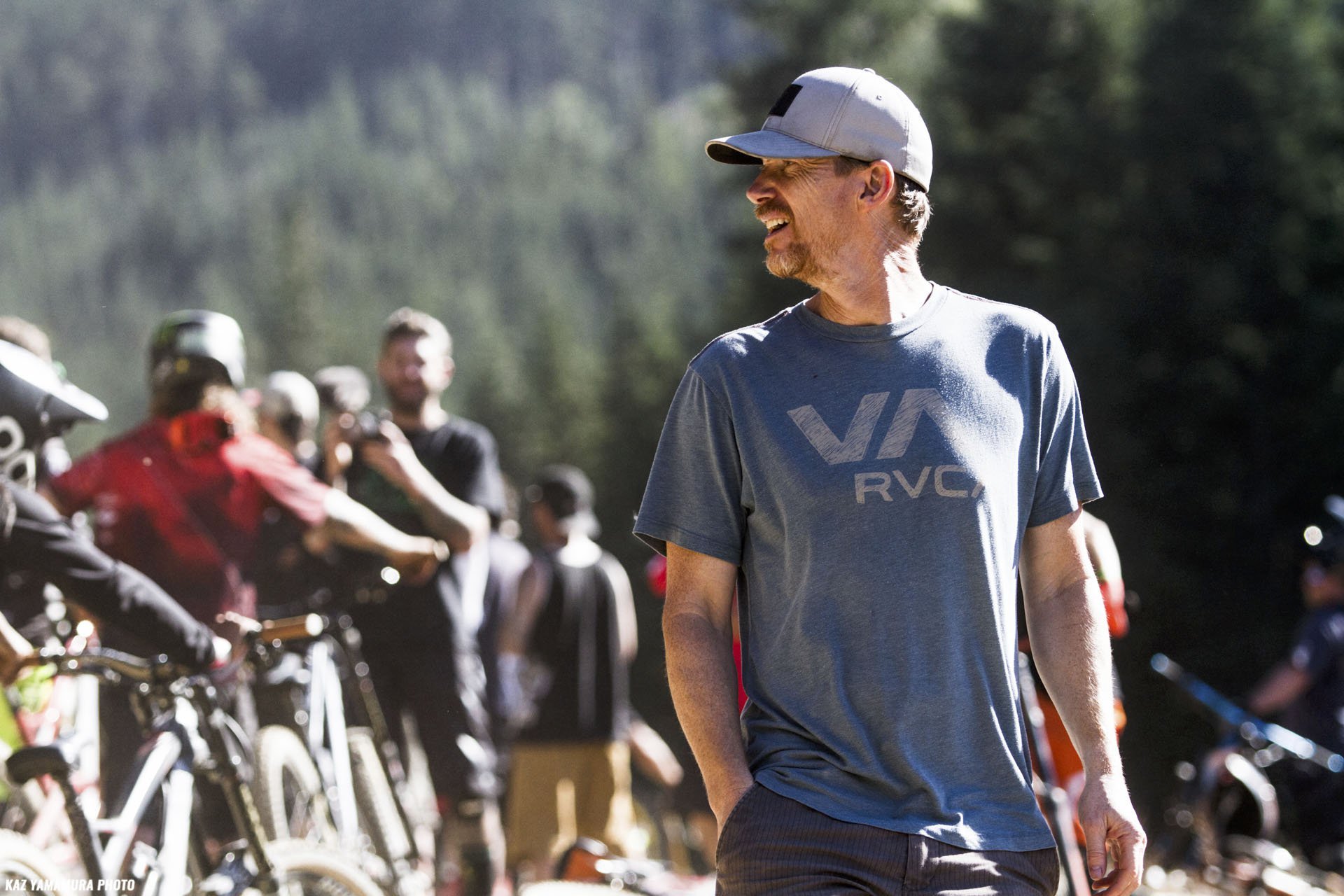
Mike watching Ben at Whip Off Worlds at Crankworx Whistler. Photo - Kaz Yamamura
It doesn’t take a genius to realize what worked then no longer applies, and our riding position hadn’t kept with the times. Not to mention the fact that Ben’s tips were obviously working for him. Which led to me thinking about riding with my legs more extended, my head up, and my shoulders up and a little bit back. This all felt pretty good for the first couple of rides, and I noticed I was interpreting the ground differently. Jumps or gaps that seemed unheard of previously started to make sense and steep bits appeared less so, but the change wasn’t monumental.
And then maybe something started to click. We rode a line I’d only ridden once, on a dry summer day. I don’t remember liking it very much or finding it very difficult. Last Friday however, it was a slimy porcelain waterslide and there seemed to be one narrow slit of a line which had no regard for our safety.
Do our postural choices lead to an increase or decrease in the amplitude or strength of the automatic postural responses that are encoded in our spinal “circuits” and brain stem? - Chris Kilmurray
Mike was leading and going fast and I was second, and we just kind of slithered down the entire trail. It seemed like it should have been terrifying, but I felt uncommonly at ease. My bike was working great but there was something fundamentally different about the quality of my experience. Some of my other compadres didn’t fare so well, and were not tickled by the trail even a little bit.
A couple of days later on a different trail and a different bike, I rode a steep, multi-pitched line that is long and very intimidating. I’d ridden it a week earlier in better conditions, and at a certain point it was as if all traction had disappeared and I ended up tripoding down the final pitch. When I returned recently, that slippery section went unnoticed by me while my companions both had problems, and I found myself releasing my brakes on pitch 2, feeling perfectly in control.
I’m sure my posture is still a mess and the odds that I’m doing anything correctly are very slim, and yet already I've felt like a completely new mountain biker. Or I did until today when things were not clicking. I had some close calls but I rode all the difficult moves I’d wanted to. It’s just that I felt stiff and awkward and was struggling with my body shape on the bike. The gains I'd made were nowhere to be found which makes it clear that professional help is in order.
Despite today’s exception, my recent experiences have lit a fire under me to rehabilitate my riding posture and make it mesh better with the long, low, and slack bikes we’ve been piloting. I have a lot of research to do and hope to get some one-on-one time with Ben’s coach in Squamish and talk to people like posture guru Chris Kilmurray, to help refine the process, and hopefully bottle some of that magic I tapped into last week. I'm particularly interested in how our body position can alter the way our body interprets risk and makes decisions, as mentioned by Chris in this article on his blog. In the meantime, see how a more upright posture feels to you and let me know if you have any revelations.
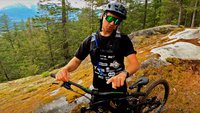
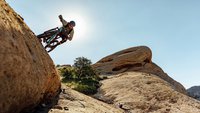
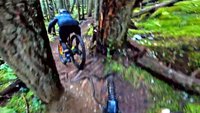








Comments
Jitensha Kun
3 years, 10 months ago
No - my riding position is from 1996.
Reply
Cam McRae
3 years, 10 months ago
Lol. You should build a shrine!
Reply
Hugo Williamson
3 years, 10 months ago
A close friend and top 35 EWS rider was talking about this from a different angle. I had just bought a new 150/140 FS trail bike, and he said take all settings off, set sag and then dial in the manufacturer’s compression and rebound settings appropriate for your weight.
Then ride in the centre of the bike upright as much as you can, it will generate grip at both ends, if it feels “ mushy “ at the back, then you are not riding in the centre of the bike!
Many folk, instead dial in more compression damping and more rebound damping to compensate for poor body position, thereby reducing rear end grip particularly over low speed chatter, or claim the shock is no good and swap it out!!
Rider error not the suspension/ shock..... the old saying “ poor workman blames his tools” springs to mind.
His final comment was try to ride the bike off the pedals through the bottom bracket like a polo pony rider!
Reply
Cam McRae
3 years, 10 months ago
When you start adding in suspension settings things get complicated but it’s clearly an essential part of posture evolution. It reinforces the need for lots of experimenting and trial and error and avoiding complacency. So much meat to dig into here.
Reply
Pnwpedal
3 years, 10 months ago
I've been a bike setup nerd for a long time, and I have absolutely been overthinking it. I realized this on my new Ibis Mojo HD5. Ibis has awesome manuals and setup instructions, with their "traction tune" setup that has as little damping as humanly possible on the 36 Grip 2 and Float X2 dampers. Weight only the pedals (my decision there), set up the generous recommended sag, dial in the minimal damping, and let 'er rip. It's responsive, lively, and poppy without feeling like too much to handle. I would wager that most modern bikes can benefit from less damping and a more centered stance over the pedals.
Reply
Morgan Heater
3 years, 10 months ago
It's pretty crazy how much easier being dynamic on the bike makes a trail feel.
Reply
JVP
3 years, 10 months ago
More fun, too. It encourages you to play around.
Reply
Dude@
3 years, 10 months ago
Great article! I have been slow to adapt, but part of this is what I will refer to as the intermediate geometry, which falls between old school and new school. Bike companies have been making bikes longer and slacker incrementally. I get it, get people use to it and then make it slightly longer. However, this intermediate geometry that mixes old school and new school riding posture doesn't work as it requires a lot of work/balance to maintain control and grip. It took me a while to figure it out.
I moved up to a newer school 140mm geometry and my riding suffered. I went into bike depression, my skills and confidence fell apart. Because of this, I went backward toward bikes that optimized older riding positions. However once you taste the longer geometry, you recognize its benefits, but it needs to work for you.
Along the way, I got the Specialized Enduro 2020. I was scared of this bike because it was even longer. I thought there is no way I can ride this bike. Even though this bike is a beast, my riding position moved more forward and with more confidence. I am loving it and I needed that step further in geometry to improve my riding position. Surprisingly, I am in a similar position with a shorter travel Ibis Ripley V4 because of the steeper head angle, longer reach. They support each other in similar riding positions. I have tried other bikes and find a lot of the 140-150mm travel bikes have geometries that fall between the Enduro and Ripley V4, and these bikes are actually harder to ride. The reason they are harder to ride, is I believe the positioning forces you into an older school form, yet you need more weight on the front for grip. The bike fights your instinct and weighting. It becomes a difficult balancing act.
Therefore, bike geometry will influence riding style, it forces you in position based on balance. You will know immediately whether it forces your butt backward or if you are more forward and balanced. Even if I wanted to change riding style, I couldn't because of weight balance.
I am bike nerd with geometry. I know what I like with respect to fit. I can adjust weighting with spacers, stem, bar rotation etc, but some bikes force you into position that is very difficult to overcome with reasonable stem, bars, etc even when you know what you are trying to achieve.
Reply
Cam McRae
3 years, 10 months ago
Excellent point about the incremental nature of change. We’re like frogs in water that has slowly been increasing in temperature, just doing the same things while our environment moves away from our ideal parameters.
This speaks to mountain bikers’ and MTB culture’s disdain for coaching and instruction. We feel like we should figure it all out ourselves and carve our own paths. Sometimes this is positive but often we suffer as a result. Great input Dude@!
Reply
Pete Roggeman
3 years, 10 months ago
Second this, after decades without, I'm keen to dig deeper and get professional eyes to help me get better.
Reply
DB@EB
3 years, 10 months ago
I’d love to help out. You guys know how to get a hold of me, so hit me up and let’s dig deeper!
DB@EB
Reply
Cr4w
3 years, 10 months ago
When I finally got a bike that was long enough to fit me correctly it came with a wheelbase to match. These longer bikes finally match my center of gravity and I'm finally correctly place fore-aft on the bike after years of too-short rear ends. Long wheelbases may suit my height but they are still long and need to be driven a certain way to navigate tight trails. I was kind of promoted to a new position whether I liked It or not. Turns out that the better body position on the bike now allows me to hit these trails faster than ever before because geometry/fit/position/technique trumps travel every time.
It's really noticeable when I ride with friends who haven't undergone the same adaptation and they're generally slower especially when it comes to aggressive downhill cornering which just can't be done well if your weight is back and arms straight.
Reply
DB@EB
3 years, 10 months ago
I’d love to chime in with some modern coaching thoughts, if you ever wanting some Positioning insight, Cam and NSMB.com team.... I can share some insight from Endless Biking and the PMBIA, who trains Instructors & Guides all over the world.
Hit me up with some questions, via email, if you wish Cam!
👍🏼
DB@EB
Reply
Arama
3 years, 10 months ago
Darren,
Lets get that clinic going bud. I've got a bunch of old dogs who need to learn some new tricks. Just emailed you!!
Arama
Reply
IslandLife
3 years, 10 months ago
Ha! I stopped riding in about 2009. My last bike before I stopped was a 26" 2007 Brodie Hoodlum that I over-forked with a Domain coil... plus when I bought that bike, my thought process was "gotta get the smallest frame I can ride... it'll be so flick-able and fun"....
Started riding again in 2018... with a bike that had the interim geometry (w/ 27.5) you speak of... I had a great year on it shaking the rust off and re-learing how to ride. Next year I went long, low, slack and 29'r... it took me a solid two months of riding before it finally clicked... I had to put myself way more forward than I had ever used to... and attack vs the old hang off the back of the bike and pray... but once I did, it was like unlocking the key to speed and flow... I'm loving it.
A buddy told me the other day he was talking to a photographer... and he thinks part of the reason everyone is so obsessed with the extreme elbows-out-at-all-costs thing is because those are the shots that look good... photographers are grabbing 20+ shots of a world cup rider flying by... and they pick the one shot that they think, and what they think we think, looks awesome.. that moment when the rider to probably pumping, or soaking up an obstacle or whatever... and has their elbows way out and they're all low... but they are definitely not always riding elbows out and low. That position just happens when it needs to happen. But now, we keep seeing images of it and think we all need to be riding like that 100% of the time.
Tip that was taught to me not to long ago and I usually say it to myself when I drop in - "Ridin Dirty" = loose, bow legged a bit, pumping to the trail's beat, give your self space and looseness to move and tip the bike back and forth below you. Seems to help me loosen up... open up my body and remember to move the bike more and let the bike move under me vs moving my body with the bike.
Reply
Reed Holden
3 years, 10 months ago
This video is a pretty good example of what this article is talking about. 6 guys with older school form getting a workshop on riding fast by richie rude who seems to have mastered the new geo/new riding form.
https://youtu.be/gmIIwaxfqKQ
Reply
Jon Harris
3 years, 10 months ago
This is a great topic Cam. I've been thinking a bit along these lines recently but it started more with my cockpit setup. I recently realised that my bar roll is significantly different to what it was years ago and that thought that this was realted to current bike geometry. I used to roll my bars forward to force me into a more aggressive over the front elbows out position. My bar roll is a lot more neutral now as I ride more centered in the bike. With that my brake levers are a lot flatter than they were too.
Lots to think about here.
Reply
Cam McRae
3 years, 10 months ago
So many intricacies. It seems the only solution is to keep changing lots of little things systematically, leaving no stone unturned. Both our bodies/position and our equipment. Looking forward to learning some stuff to share in my session with Joel.
Reply
Tremeer023
3 years, 10 months ago
I used to ride medium sized frames as seat tubes were historically too long. The reach was scarily short on some older bikes with short stems. I'm 5,11 and ride large size now so in many ways the jump to modern geometry and fit has been compounded.
I remember buying a custom built ht frame (Curtis SX) in about 2006 and requested the longest top tube (22.75 inch). The builder quizzed me at the time suggesting it may be too long but it felt great at the time having a short seat tube and longer reach.
Reply
Andy Eunson
3 years, 10 months ago
There are parallels with skiing and probably other sports too where improvements in equipment change the “mechanics” of how you do stuff. You can still a frame and slide skis but a better stance with slightly wider feet and doing less allows you to carve skis much better. Fat rockered skis work better in powder too. I think we are starting to see bikes get longer rear centres for larger frames too. Some modern bikes seem to be BMX out back, downhill out front.
Reply
Cam McRae
3 years, 10 months ago
Skiing is a great parallel. I seem to recall carving was mainly done with the outside foot rather than both together? Equipment evolution isn't worth much if the technique doesn't follow along.
Reply
Jonas Dodd
3 years, 10 months ago
Wait a minute, you're younger than me?!
Reply
Cam McRae
3 years, 10 months ago
Moi? Highly unlikely, but possible.
Reply
Mike Wallace
3 years, 10 months ago
Bens coach as mentioned:
https://blueprintathletedevelopment.com
Reply
[user profile deleted]
3 years, 10 months ago
This comment has been removed.
Cam McRae
3 years, 10 months ago
It's probably not an accurate representation considering I'm on a log, four feet of the deck, with no obstacles or impacts, but I think I see a subtle difference between what I see there and what I'm aiming for now. In that shot, my back is bent forward and I think I perform better and my biomechanics improve when my spine is neutral or even slightly arched back, raising my head and shoulders a wee bit.
It may turn out that I wasn't too far off. I have no idea really, but considering what a difference that small change has made I've probably got a long way to go!
Reply
[user profile deleted]
3 years, 10 months ago
This comment has been removed.
Velocipedestrian
3 years, 10 months ago
Thanks Cam, very timely. I've been thinking about my (shitty) form most rides recently, and thought about this article on last night's ride.
More upright, head higher etc felt like it gave me more room to pump, and changed my cornering focus from thinking about the arc my bike/feet are making, to thinking about my head making the arc, and everything below following through loosely.
I did ruin the clarity of the experiment by changing an extra variable though, swapped out the 480lb spring for a 500lb, no doubt this helped the mid stroke for pumping.
Reply
jordankenna
3 years, 10 months ago
Great article Cam. While it's never intuitive for me, often will force myself to look further down the trail than normal -- and it tends to yield an improvement with smoothness and speed, aka more fun. Maybe the longer sightline pulls me into a more upright stance - or maybe it's just a low stance with my neck torqued up which would have Ben cringing. An hour of a coach's time would clearly go a long way vs. remaining a piece of furniture thinking 'i got this'....
Great hearing your experience on the greased porcelain!
Reply
Cam McRae
3 years, 10 months ago
Thanks Jordan!
I may need some extra bodies for my future session. LMK if you are keen.
Reply
jordankenna
3 years, 10 months ago
Definitely in!
Reply
kain0m
3 years, 10 months ago
I think the majority of people ride too far back. The front wheel needs much more attention (read: pressure) than we give it intuitively, especially with slack head angles and long bikes.
And then there is the point of ellbows out: It is necessary. But it is also necessary to have movement in both directions.
My way of thinking about this is: On a bike, 80% of the mass is the rider, and 80% of that is the torso and head. If this mass is stuck in any corner, it limits the amount the whole system (i.e. bike + rider) can move before it looses control - this is true in both directions. The same way that a trophy truck has 50% negative travel, the rider needs to be centered in his or her "travel" - that is arms and legs.
A dirtbike on a pump track is great training for this - you can't move swiftly ony pumptrack if you rely on suspension. Once your riding posture is where it needs to be, you have the ability to "pull the bike towards you" on the uphill part of a hump, and push yourself perpendicularilly off the inclined plane on the way down.
On a FS bike, you want to acheive the same thing - a "resonance" with the bike and terrain. Release pressure on the way up, and push on the way down. This generates the flow in your riding - you work with the suspension, not against it. And it most certainly isn't possible when you aren't centered in your "travel" - because then, you are stuck with reacting instead of acting.
Reply
Glass
3 years, 10 months ago
In 2016 I bought a Pole Evolink 176 with 510mm of reach. My previous bike had 450mm of reach and the one before that 430mm. I am 180cm tall (5'11"). Like with skis the longer reach bike needs you to weight the front more in order to make the bike turn. I ended up riding more in the center both going up and downhill. Even though I went from a 1225mm wheelbase to 1340mm I have found it easier to turn on the longer bike. Riding in the center of the bike allows you to shift your weight from front to back wheel more easily, makes going over the bars much harder and allows you to drift the bike more easily. I was stunned by the grip I could get on the steep downhills compared to my previous bike. Now when I switch to shorter bikes they just feel so sketchy and require me to ride them off the back.
Most of my friends refuse to get longer bikes (bikes that fit them) because they still ride off the back.
Reply
Greg Bly
3 years, 10 months ago
My 2006 specialized Enduro has a 12 .5 inch bb. And I have a large frame. HT angle is a tad steep but that when over forking works. My 2006 Devinci has a high BB which I like and a 65 degree HT angle.
Long slack and low was on everyone's wish list since early 2000 . The bike industry is very slow to change. One by drive trains ? That's not new . We used to attack climbs out of saddle now we have steep seat tube angles and dropper post. Seated climbing is not an advantage. Modern suspension tunes are stiff and make the bike feel dead.
The trick isn't in the set up it's in something you mentioned. Riding relaxed. If I'm singing a song and smiling everything flows . If I'm thinking about my posture when riding I'm most certainly not relaxed.
Have to admit I chuckle every time I see a rider with stiff arms elbows locked out , ass in the air it looks uncomfortable and comical.
I ride over the front end , in the middle and behind the bike . Sometimes low sometimes upright like a trials rider.
Nothing wrong with bikes from 2006 in fact it's my favorite vintage for mountain bikes. The rider makes the bike dance not the bike.
Reply
Cam McRae
3 years, 10 months ago
Not at all. Lots of fun on those older bikes. Just don’t expect to win an EWS! I’ve got a Dekerf from ‘93 that i still enjoy riding and if I don’t get loose it beats the hell out of me!
Reply
Greg Bly
3 years, 10 months ago
Hand built and locally built hard tail. I can see why you held on to the Dekerf . Race in EWS ? Then I would have to ride fast! I just ride for fun. On a group rides I'm the cabose :)
Reply
kain0m
3 years, 10 months ago
This comment has been removed.
spookie967
3 years, 10 months ago
I did a half day riding with a MTB Coach last year to get some professional pointers. Turns out my idea of being centred on a bike was way too far back. With a few other minor adjustments I found myself looking down trail more and eventually riding some sections that I had previously baulked at or rode hanging on waiting for a crash. Subtle changes that have made a big difference to how and what I now ride.
Reply
dave_f
3 years, 10 months ago
It took me awhile to figure out how to try and say what this article got me thinking about. Taj Mihelich's bike check and his statement that getting on a long travel 29er is like becoming a passenger and hanging up your bike skills etc. articulates a bit of the part I'm not sure about. I get the argument that modern bike geometry gives you more leeway balance-wise, maybe making it easier to try a different posture. I'm not sure it's the key to unlocking next level riding.
Sometimes you see something inspiring and think to yourself "If I could make a wish and wake up tomorrow and look like XYZ when riding that would be it" For me, Brandon Semenuk's unreal segment is a prime example. That was 5 years ago. Pretty sure he was riding with that style in 2006.
Reply
Please log in to leave a comment.